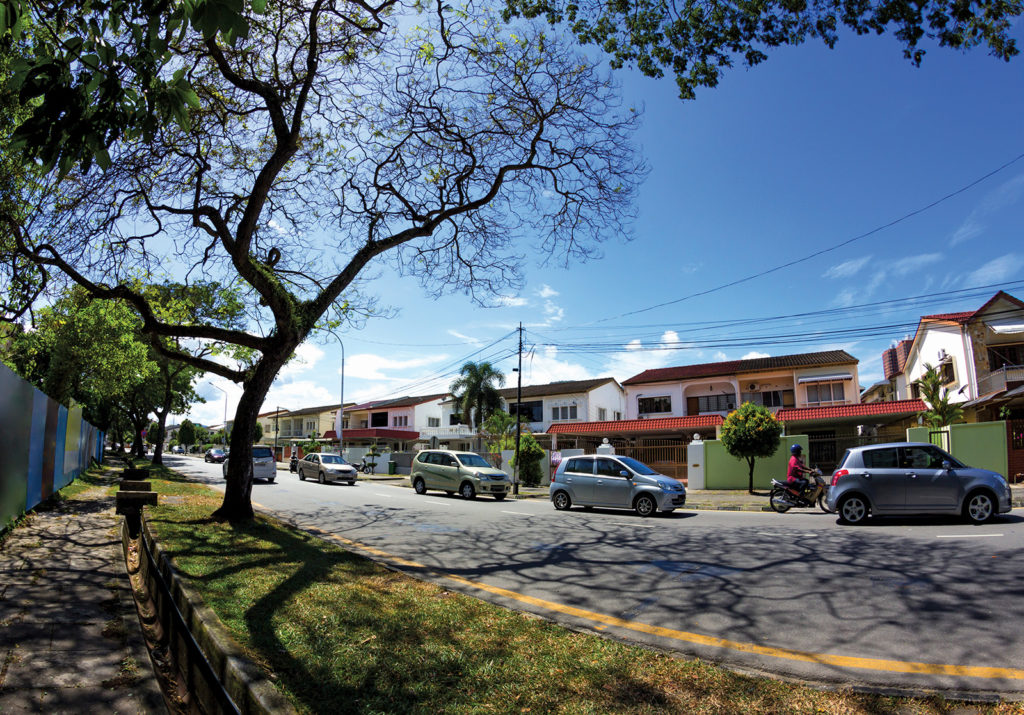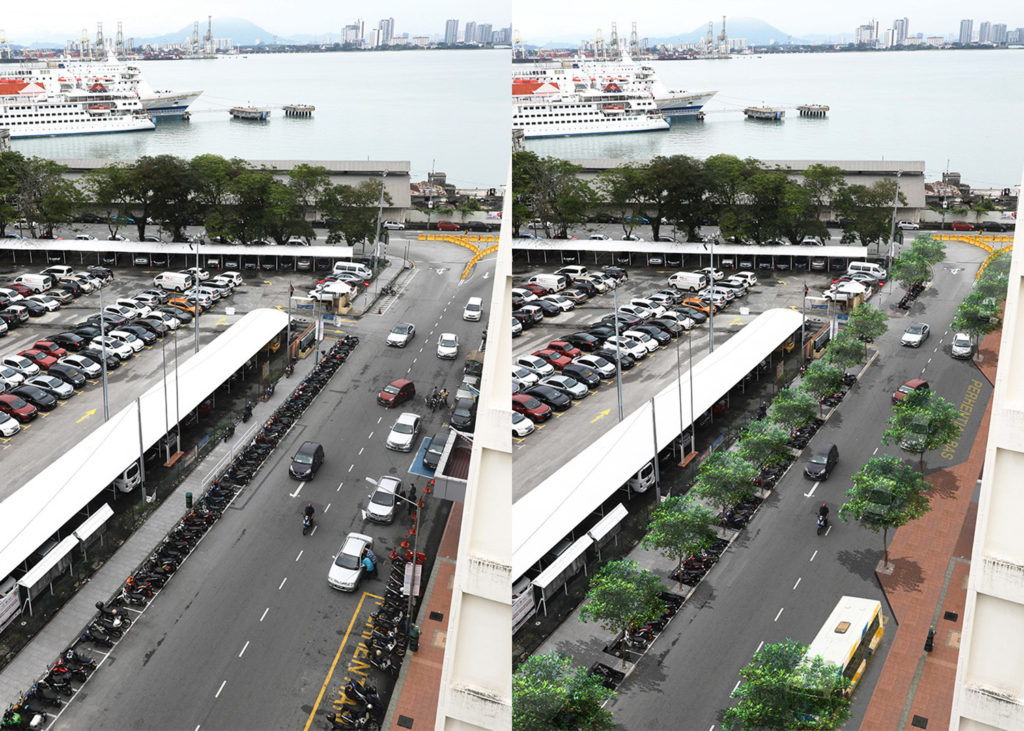Climate Feature: Cultivating the Right Tree in the Right Place
June 19, 2023

Did you know that many of the oldest living organisms on Earth are trees? In fact, the Methuselah Tree, a Great Basin Bristlecone Pine, was thought to be the oldest living tree in the world. What does an ancient living species have to do with today’s city landscapes? For one, Earth’s biosphere and ecology will not survive without them, let alone any manmade settlement.
With this in mind, along with this issue’s focus on the beauty and wisdom of all things old, Melissa Sivaraj shares insights on how this long-living species in present urban settings is crucial to climate change mitigation, and why cultivating them rightly is the key to longevity for both humans and trees.
Trees are an integral part of Malaysia’s history and identity, with some lending their names to local places. For example, Tanjong Penaga, now known as George Town, Penang, was named after the Penaga Laut trees that once grew there in abundance.
Beyond their cultural values, trees play a crucial role in mitigating the effects of climate change and improving the quality of life for citizens. On a city level, they reduce the urban heat island (UHI) effect, which causes urban areas to experience higher temperatures than surrounding rural or natural ones. They do this by providing shade and through evapotranspiration, where the roots absorb water and transport it to the leaves. There, it evaporates and cools the surrounding air.
A recent study in The Lancet emphasises the effectiveness of planting trees to reduce the UHI effect1. It found that the UHI effect causes more premature deaths in cities with low tree coverage. For example, Cluj-Napoca, Romania, has a tree coverage of 7 per cent and a UHI effect of 2.4 degrees Celsius. In 2015, 32 people died prematurely due to its UHI effect. Meanwhile, Gothenburg, Sweden, has a tree coverage of 27 per cent and a UHI effect of only 0.4 degrees Celsius. In the same year, no one died prematurely due to the UHI effect.
NATURE-BASED SOLUTIONS FOR MALAYSIAN CITIES
Think City, an impact organisation that makes cities more liveable and sustainable, collaborated in 2019 with UN-Habitat, Ministry of Environment and Water (now known as Ministry of Natural Resources, Environment and Climate Change), Penang State Government, Penang Island City Council, Department of Irrigation and Drainage, and Yayasan Hasanah, to initiate the first urban climate adaptation programme for Malaysia, the Nature-based Climate Adaptation Programme for the Urban Areas of Penang Island. It involves adapting to the UHI effect by introducing new tree-lined streets.
We mapped the most heat-stressed areas using Landsat satellite imagery data from the US Geological Survey to identify where to plant trees and reduce temperatures. Next, we needed to determine the most suitable species to plant.


Several cities have already done this, including Melbourne, Australia10. There are 375 tree species currently planted there, and 39 per cent are moderately or extremely vulnerable to the existing temperatures. Other tree species, however, appear promising for Melbourne. For example, research shows that 788 tree species planted in different cities can tolerate current and future temperatures in Melbourne, providing an opportunity to improve the city’s resilience. No such study had existed for Malaysia yet.
As a result, Think City initiated a study of climate resilience with 251 urban tree species in Malaysia. We worked with experts who scored them according to eight climate criteria, after which we identified the most and least resilient options. We also found that many of these tree species are sensitive to saltwater and flooding.
DEALING WITH DATA CHALLENGES
Besides a lack of data, we faced challenges with outdated data or data being hard to access and use. These make urban planning and decision-making less efficient. Thus, Think City developed the Atlas of Climate Resilient Tree Species, or ACResT, an open and collaborative online database that collates data on tree species, to address these challenges.


ACResT is a tool for the pragmatic researcher, city planner and policymaker looking to create data-driven and climate-proof urban landscapes. A tree nursery directory, it helps stakeholders source hard-to-find species and bridge the gap between supply and demand; for example, if tree nurseries do not currently sell climate-resilient species.
In accounting for climate resilience in planting decisions, ACResT strives to transform Malaysia’s urban landscape and landscape industry. As Malaysia is one of the most biodiverse countries in the world, ranking 12th on the National Biodiversity Index, a better understanding of its tree species and how to manage them is critical. ACResT also aims to engage a broader audience in Singapore and Indonesian Borneo (Kalimantan) to create a more robust data pool while providing them with the same resources.
[This is an excerpt. Subscribe to the digital edition or hardcopy to read the complete article.]

Melissa Sivaraj, whose background is in conservation and research, strives to develop harmonious relationships between humans and Nature, taking a systems-thinking approach to understanding environmental challenges. Her work at Think City surrounds nature-based solutions. Here, she co-developed A Study of Climate Resilience in Urban Tree Species of Peninsular Malaysia with local and international researchers and helped conceptualise ACResT, an online database of climate-resilient tree species. Prior to joining Think City, she worked at The Habitat Foundation, Penang, where her responsibilities focused on science communication, project management and community engagement. Sivaraj holds a Bachelor of Science in Wildlife and Fisheries Biology, and a Minor in Animal Science from The University of Vermont.
Related stories:
An Ecologically Sensitive Continuation of the Old Tai Po Police Station: Green Hub



Read more stories from FuturArc 2Q 2023: Old is Gold!

References:
1 Lungman, Tamara, Marta Cirach, Federica Marando, Evelise Pereira Barboza, Sasha Khomenko, Pierre Masselot, Marcos Quijal-Zamorano, et al. “Cooling Cities through Urban Green Infrastructure: A Health Impact Assessment of European Cities.” The Lancet 401, No. 10376 (January 2023): 577-589. https://doi.org/10.1016/S0140-6736(22)02585-5
2 Zainal, Fatimah. “Floods: 55 Fatalities from December 2021 to January 2022.” The Star. March 8, 2022. https://www.thestar.com.my/news/nation/2022/03/08/floods-55-fatalities-from-december-2021-to-january-2022
3 Rahman, Serina. “Malaysia’s Floods of December 2021: Can Future Disasters be Avoided?” ISEAS Perspective. March 16, 2022. https://www.iseas.edu.sg/articles-commentaries/iseasperspective/2022-26-malaysias-floods-of-december-2021-can-future-disasters-be-avoided-by-serina-rahman/
4 Kabat, Pavel, Paul Egerton, Omar Baddour, Laura Paterson, Clare Nullis, Sylvie Castonguay, Melissa Walsh, et al. United in Science: High-level Synthesis Report of Latest Climate Science Information Convened by the Science Advisory Group of the UN Climate Action Summit 2019. World Meteorological Organization (WMO), 2019. https://library.wmo.int/index.php?lvl=notice_display&id=21523#.ZCKOdOxBw-Q
5 National Hydraulic Research Institute Malaysia (NAHRIM). The Study of the Impact of Climate Change on Sea Level Rise in Malaysia (Final Report). 2010.
6 Ministry of Energy, Science, Technology, Environment and Climate Change (MESTECC). Malaysia: Third National Communication and Second Biennial Update Report to the UNFCCC. 2018.
7 Kamaruddin, Abdul Hadi, Ami Hassan Md Din, Muhammad Faiz Pa’suya, and Kamaludin Mohd Omar. “Long-Term Sea Level Trend from Tidal Data in Malaysia.” 2016 7th IEEE Control and System Graduate Research Colloquium (ICSGRC) (August 2016). DOI: 10.1109/ICSGRC.2016.7813325.
8 Ariffin, Noor Fazamimah Mohd, Noor Azramalina Abdul Aziz, and Mohd Yazid Mohd Yunus. “The Significance of Heritage Trees Conservation for Urban Development in Taiping Lake Garden, Malaysia.” Alam Cipta 12, No. 2 (December 2019): 38-46. https://psasir.upm.edu.my/id/eprint/76506/1/20191231083612Paper_5_Dec_2019.pdf
9 Thomson, Lex A. J. “Pterocarpus indicus (narra), ver. 2.1.” In Species Profiles for Pacific Island Agroforestry (https://www.traditionaltree.org), edited by Craig R. Elevitch. Holualoa, Hawai‘i: Permanent Agriculture Resources (PAR), 2006.
10 Kendal, Dave and Jess Baumann. The City of Melbourne’s Future Urban Forest: Identifying Vulnerability to Future Temperatures. Melbourne: Clean Air and Urban Landscapes Hub, 2016. https://nespurban.edu.au/resource/researchreports/
https://www.atlasobscura.com/lists/worlds-oldest-livingthings
To read the complete article, get your hardcopy at our online shop/newsstands/major bookstores; subscribe to FuturArc or download the FuturArc App to read the issues.
Previously Published Commentary
Contact us at https://www.futurarc.com/contact-us for older commentaries.

